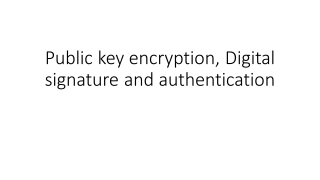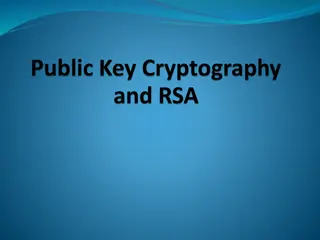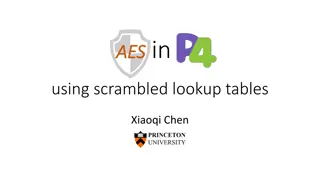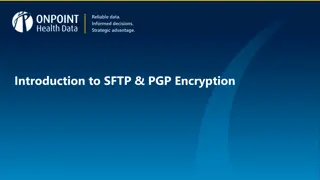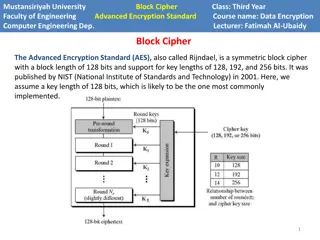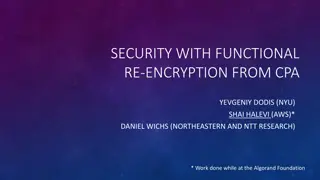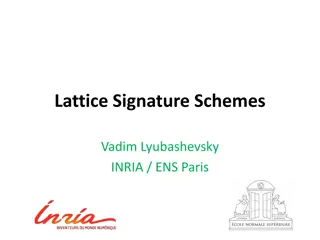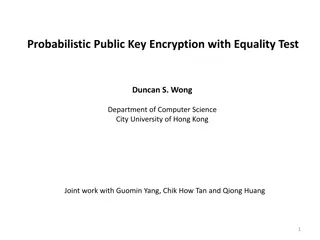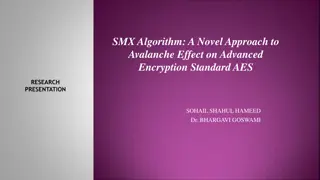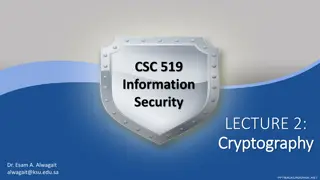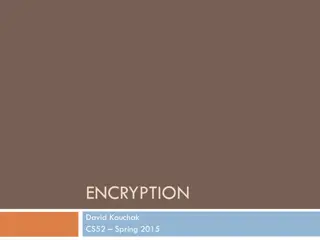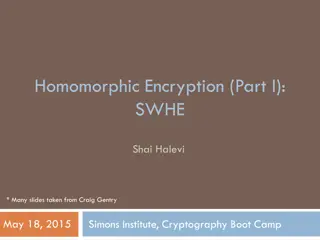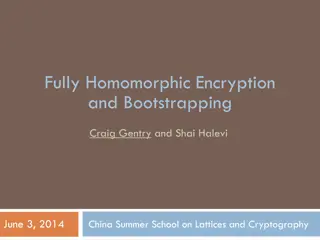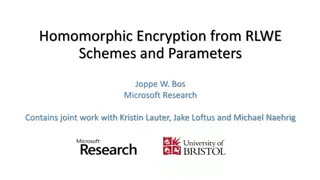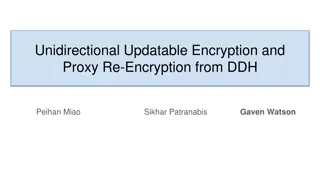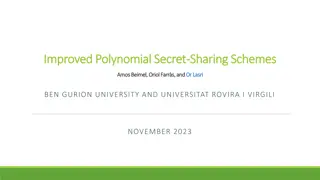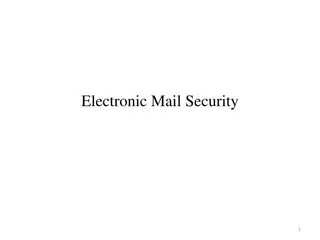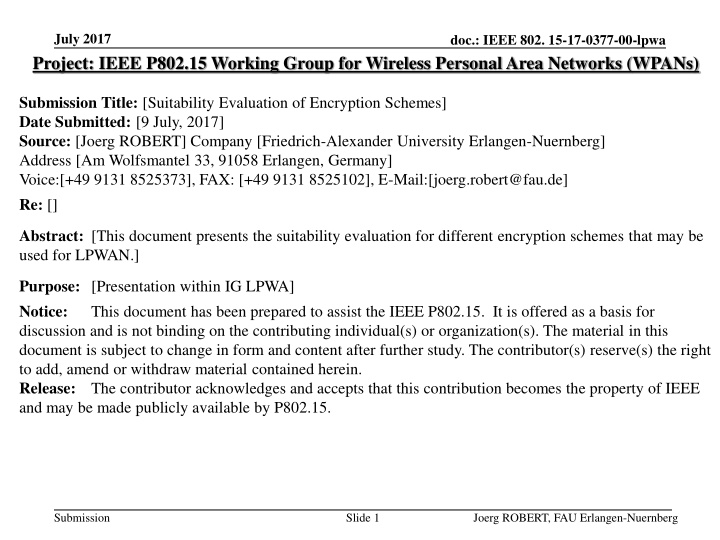
Evaluation of Encryption Schemes for LPWAN Networks
Discover the suitability of various encryption schemes for Low Power Wide Area Network (LPWAN) applications in this document submitted to the IEEE P802.15 Working Group. Explore the pros and cons of symmetric and public key encryption methods, along with considerations for key exchange and data security layers.
Download Presentation

Please find below an Image/Link to download the presentation.
The content on the website is provided AS IS for your information and personal use only. It may not be sold, licensed, or shared on other websites without obtaining consent from the author. If you encounter any issues during the download, it is possible that the publisher has removed the file from their server.
You are allowed to download the files provided on this website for personal or commercial use, subject to the condition that they are used lawfully. All files are the property of their respective owners.
The content on the website is provided AS IS for your information and personal use only. It may not be sold, licensed, or shared on other websites without obtaining consent from the author.
E N D
Presentation Transcript
July 2017 Project: IEEE P802.15 Working Group for Wireless Personal Area Networks (WPANs) doc.: IEEE 802. 15-17-0377-00-lpwa Submission Title: [Suitability Evaluation of Encryption Schemes] Date Submitted: [9 July, 2017] Source: [Joerg ROBERT] Company [Friedrich-Alexander University Erlangen-Nuernberg] Address [Am Wolfsmantel 33, 91058 Erlangen, Germany] Voice:[+49 9131 8525373], FAX: [+49 9131 8525102], E-Mail:[joerg.robert@fau.de] Re: [] Abstract: [This document presents the suitability evaluation for different encryption schemes that may be used for LPWAN.] Purpose: [Presentation within IG LPWA] Notice: This document has been prepared to assist the IEEE P802.15. It is offered as a basis for discussion and is not binding on the contributing individual(s) or organization(s). The material in this document is subject to change in form and content after further study. The contributor(s) reserve(s) the right to add, amend or withdraw material contained herein. Release: The contributor acknowledges and accepts that this contribution becomes the property of IEEE and may be made publicly available by P802.15. Submission Slide 1 Joerg ROBERT, FAU Erlangen-Nuernberg
July 2017 doc.: IEEE 802. 15-17-0377-00-lpwa Suitability Evaluation of Encryption Schemes Joerg Robert, FAU Erlangen- Nuernberg Submission Slide 2 Joerg Robert, FAU Erlangen-Nuernberg
July 2017 doc.: IEEE 802. 15-17-0377-00-lpwa Symmetric Key ( I / II ) Transmitter and receiver know the same key which has to be kept secret Pros Basis for many ciphers Relatively low encoding/decoding complexity Cons Difficult key exchange Secret key on user equipment Over the air key updates difficult Submission
July 2017 doc.: IEEE 802. 15-17-0377-00-lpwa Symmetric Key ( II / II ) Communication Mode Uplink Downlink/Uplink Uplink / Broadcast Downlink Data Length <= 16 bytes <= 64 bytes <= 256 bytes > 256 bytes Data Security Layer-2 Layer-3 End-to-End Secure Authentication Data Period Occasionally, less than 1/day Occasionally 1/day Occasionally 1/hour Occasionally, more than 1/hour Periodically 1/day Periodically 1/hour Periodically, more than 1/hour Power Supply CR 2025 2xAA Energy Harvesting External Submission Slide 4 Joerg Robert, FAU Erlangen-Nuernberg
July 2017 doc.: IEEE 802. 15-17-0377-00-lpwa Public Key ( I / II ) Transmitter uses public key for the encryption Decryption with private key that is only known to receiver Pros Basis for many authentication algorithms Private key only known to receiver Possibility of key exchange (only if uplink / downlink) Cons High encoding / decoding complexity Submission
July 2017 doc.: IEEE 802. 15-17-0377-00-lpwa Public Key ( II / II ) Communication Mode Uplink Downlink/Uplink Uplink / Broadcast Downlink Data Length <= 16 bytes <= 64 bytes <= 256 bytes > 256 bytes Data Security Layer-2 Layer-3 End-to-End Secure Authentication Data Period Occasionally, less than 1/day Occasionally 1/day Occasionally 1/hour Occasionally, more than 1/hour Periodically 1/day Periodically 1/hour Periodically, more than 1/hour Power Supply CR 2025 2xAA Energy Harvesting External Submission Slide 6 Joerg Robert, FAU Erlangen-Nuernberg
July 2017 doc.: IEEE 802. 15-17-0377-00-lpwa AES-128/256 ( I / II ) Transmitter and receiver use symmetric key Pros Well known algorithms used in many applications Acceptable encoding / decoding complexity Hardware acceleration in many embedded systems Strong protection Cons Requires symmetric key secret key inside user equipment Fixed block length of 128 bits Submission
July 2017 doc.: IEEE 802. 15-17-0377-00-lpwa AES-128/256 ( II / II ) Communication Mode Uplink Downlink/Uplink Uplink / Broadcast Downlink Data Length <= 16 bytes <= 64 bytes <= 256 bytes > 256 bytes Data Security Layer-2 Layer-3 End-to-End Secure Authentication Data Period Occasionally, less than 1/day Occasionally 1/day Occasionally 1/hour Occasionally, more than 1/hour Periodically 1/day Periodically 1/hour Periodically, more than 1/hour Power Supply CR 2025 2xAA Energy Harvesting External Submission Slide 8 Joerg Robert, FAU Erlangen-Nuernberg
July 2017 doc.: IEEE 802. 15-17-0377-00-lpwa RSA ( I / II ) Transmitter uses public key for the encryption Decryption with private key that is only known to receiver System based on prime numbers as trap-door function Pros Well known algorithms used in many applications Strong protection Method can be used for secure authentication Allows for key updates Cons Approx. 1000 time more complex than AES normally only used for key exchange Long key length of several kBit Submission
July 2017 doc.: IEEE 802. 15-17-0377-00-lpwa RSA ( II / II ) Communication Mode Uplink Downlink/Uplink Uplink / Broadcast Downlink Data Length <= 16 bytes <= 64 bytes <= 256 bytes > 256 bytes Data Security Layer-2 Layer-3 End-to-End Secure Authentication Data Period Occasionally, less than 1/day Occasionally 1/day Occasionally 1/hour Occasionally, more than 1/hour Periodically 1/day Periodically 1/hour Periodically, more than 1/hour Power Supply CR 2025 2xAA Energy Harvesting External Submission Slide 10 Joerg Robert, FAU Erlangen-Nuernberg
July 2017 doc.: IEEE 802. 15-17-0377-00-lpwa Elliptic Curves ( I / II ) Transmitter uses public key for the encryption Decryption with private key that is only known to receiver System based on discrete logarithm as trap-door function Pros Similiar properties to RSA based on prime numbers More difficult to hack compared to prime numbers for similar key length shorter keys Method can be used for secure authentication Allows for key updates Cons Significantly more complex than AES Submission
July 2017 doc.: IEEE 802. 15-17-0377-00-lpwa Elliptic Curves ( II / II ) Communication Mode Uplink Downlink/Uplink Uplink / Broadcast Downlink Data Length <= 16 bytes <= 64 bytes <= 256 bytes > 256 bytes Data Security Layer-2 Layer-3 End-to-End Secure Authentication Data Period Occasionally, less than 1/day Occasionally 1/day Occasionally 1/hour Occasionally, more than 1/hour Periodically 1/day Periodically 1/hour Periodically, more than 1/hour Power Supply CR 2025 2xAA Energy Harvesting External Submission Slide 12 Joerg Robert, FAU Erlangen-Nuernberg
July 2017 doc.: IEEE 802. 15-17-0377-00-lpwa Over the Air Key Update ( I / II ) Network updates key Pros Improved security Simple reconfiguration Cons Requires asymmetric encryption Requires bi-directional communication Submission
July 2017 doc.: IEEE 802. 15-17-0377-00-lpwa Over the Air Key Update ( II / II ) Communication Mode Uplink Downlink/Uplink Uplink / Broadcast Downlink Data Length <= 16 bytes <= 64 bytes <= 256 bytes > 256 bytes Data Security Layer-2 Layer-3 End-to-End Secure Authentication Data Period Occasionally, less than 1/day Occasionally 1/day Occasionally 1/hour Occasionally, more than 1/hour Periodically 1/day Periodically 1/hour Periodically, more than 1/hour Power Supply CR 2025 2xAA Energy Harvesting External Submission Slide 14 Joerg Robert, FAU Erlangen-Nuernberg
July 2017 doc.: IEEE 802. 15-17-0377-00-lpwa Any Questions or Comments? Submission Slide 15 Joerg Robert, FAU Erlangen-Nuernberg

